Isle of Portland
"The hoary peninsula called an island looked the same as before .... The silent ships came and went from the wharf, the chisels clinked in the quarries, file after file of whitey-brown horses .... pain"
Thomas Hardy, The Well-Beloved
Situated near Weymouth, the little Isle of Portland is connected to the mainland by the picturesque but dangerous Chesil Beach. Portland Isle is an integral part of the Jurassic Coast, a UNESCO World Heritage Site in Dorset. A tranquil place, Portland is ideal for birdwatchers, windsurfers, divers, climbers, walkers and heaven for anyone interested in geology and archaeology.
Just 6km long and 2.4 km wide, the Isle of Portland has three castles within its boundaries. The oldest of these, Rufus Castle lies at Church Ope Cove. Situated on the cliff edge, much of the ruins of the castle have been reclaimed by the sea. Probably built by King William Rufus, Rufus Castle is a Norman structure in the shape of a pentagon. it is often known as the Bow and Arrow Castle due to number of loopholes in its walls.
Nearby lies Pennsylvania Castle which was built at the turn of the 19th century by James Wyatt for John Penn. It was designed as a stately country home for the grandson of William Penn, the founder of Pennsylvania in the U.S.A. A hotel in the 1980's, Pennsylvania Castle is now a private home.
Portland Castle is the last and most magnificent of Portland's castles. A Tudor fortress, Portland Castle has overlooked the Portland Harbour for over 460 years. Although Portland Castle was originally built by the Crown for protection in face of a foreign invasion, its stormiest days were seen during the English Civil War. Over the centuries, Portland Castle also served as a private home and an army residence.
Limestone is Portland's main natural resource and is visible throughout England having been used in some of the country's finest buildings such as St. Paul's Cathedral, the National Gallery, the Greenwich Royal Naval College and the Whitehall cenotaph.
Portland offers great walking and it's definitely worth making your way to the southern tip of Portland to visit Portland Bill. Here you'll find a lighthouse which has guided ships safely past the promontory ever since the 18th century. The present building dates from 1906 and is also home to Lighthouse Visitor Centre which details Portland's history and gives outstanding views of Chesil Beach. Another attraction at Portland Bill is the Portland Bird Sanctuary and Field Centre, a haven and delight for birds and birdwatchers alike.
Chesil Beach
Joining the Isle of Portland to the mainland, Chesil Beach extends for some 17 miles from Chesil Cove in the west to Bridport in the east. Sometimes dubbed "Great Beach?, Chesil Beach works as a natural barrier to the Fleet Lagoon. Due to the movement of the sea this shingle beach has a graded form with pebbles getting smaller the closer you get to Bridport. Flint pebbles, Purbeck Chert Pebbles, Budleigh Salterton Pebbles, granite and porphyry provide a wide range of delight for geologists. The less erudite can search for "Hag Pebbles" identified by a hole in their centre.
Besides pebbles, there's something for everyone and the more adrenalin inclined are equally provided for. A major attraction for divers, Chesil Beach is littered with wrecks and experienced divers head for the Royal Adelaide, Chesil Cove and the Landingcraft. Having said that, Chesil Beach remains one of the worst possible places you could ever go for a swim due to severe underwater tidal currents. Unless you really know what you're doing, the best way to enjoy the place is by taking a walk along part of the South West Coast Path. Chesil Beach is also renowned for fishing and local hot-spots are considered to be Chesil Cove, the Royal Adelaide wreck, Abbotsbury and West Bexington.
The Fleet Nature Reserve is one of the areas along Chesil Beach where access is controlled. A wetland, the Fleet Nature Reserve is a sanctuary for birds and one of the most important tidal habitats to be found in Europe. As well as a bird breeding ground, Fleet Nature Reserve also provides a protected habitat for some 60 mollusc species and over 150 seaweed species. At the Fleet Nature Reserve's western end lies the Abbotsbury Swannery home to a colony of mute swans for over 600 years.
Location of Isle of Portland




